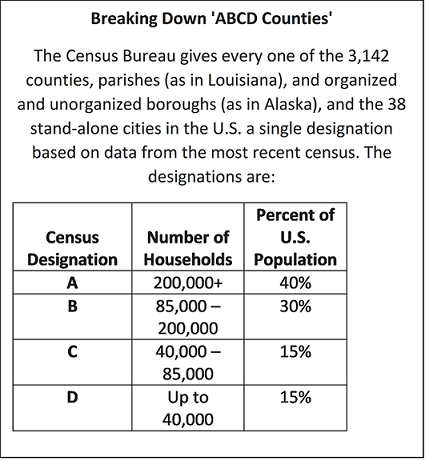It’s the fundamental definition of marketing: meeting the needs of customers at a profit. And that includes offering the right products or services, at the right price, where and how the customers want to purchase. But who are these customers? Are you sure you know? And are you sure you are talking to all customers?
This 2012 Harvard Business Review article sums it up: “Most companies are the centers of their own universes. It’s a natural enough impression; after all, the products and services they offer are on their minds 24/7. The trap is in those companies deluding themselves into thinking that they are as important to their customers as they are to themselves. This is almost never the case. This delusion interferes with understanding customers and their needs, and frequently leads companies to talk to customers in ways that seem foreign or confusing.”
Being immersed in our own concerns as marketers may give rise to a blind spot that skews the way we think of the customer and their world. Maybe, instead of “the customers” we need to remind ourselves to serve “ALL the RIGHT customers”. And that begins with marketing research: how do we get the information we need from the right people?
Walk in the Customers Shoes
If you work for a Fortune 500 company, you probably are not the typical customer. If you work in corporate HQ in marketing or market research, you are not typical. You are probably better educated, financially better off, have a lot more social capital, are more urban, and so forth, than the median American. Even if you work in a manufacturing facility in a small town you may be more like the median American, but being an employee skews your view of the company. You’ve probably heard that old recommendation to set a budget a based on the median U.S. household income and then shop for groceries to feed your mythical family of four on that amount. An interesting and challenging exercise! Create a relevant variation for your customer.
Learn your ABCs and Ds
Approximately 30% of U.S. population is in C and D counties which, by definition have less than 85,000 people in them. Further, these counties skew differently  from more urban communities in various demographic and socioeconomic ways. (For more information about these markets, check out this article from The New York Times) Think about what you are marketing. Some brands may not have much relevance with this group, but many brands do, and some brands are overdeveloped in these markets. If you are selling something mainstream, like peanut butter, you need to be sure the views of this 30% is represented. In addition to C and D counties, you might look at regions or states that are infrequently researched. When is the last time you did a focus group in Des Moines, IA, or Omaha, NE? (And this is not just about qualitative research. We need to make sure our panel samples represent all of the population we need to sell to – not just those in major metropolitan areas.).
from more urban communities in various demographic and socioeconomic ways. (For more information about these markets, check out this article from The New York Times) Think about what you are marketing. Some brands may not have much relevance with this group, but many brands do, and some brands are overdeveloped in these markets. If you are selling something mainstream, like peanut butter, you need to be sure the views of this 30% is represented. In addition to C and D counties, you might look at regions or states that are infrequently researched. When is the last time you did a focus group in Des Moines, IA, or Omaha, NE? (And this is not just about qualitative research. We need to make sure our panel samples represent all of the population we need to sell to – not just those in major metropolitan areas.).
Talk to the People
Qualitative research may actually be a great first step in learning about your overlooked customers. Because qualitative is descriptive and not projective, you don’t need to worry about a representative sample. The best way to understand the perspectives and lifestyle of any group of people is to talk to them. Go out there and understand their points of view. You can do this either before or after quantitative research. Most importantly, keep an open mind! The point here is to test your assumptions. Be prepared to listen respectfully. Keep in mind that many people may live differently than you do, but they still know their own needs and preferences and it is your job to fulfill them
Think Hyperlocal
In addition to cities you might not typically choose to include in your research, think about the specific facilities and where they are located. Don’t choose facilities based on how close they are to the airport, or what’s convenient for you. Make sure the demographics of the areas surrounding the facility match your target audience. Make sure you schedule your groups to meet the needs of your respondents. For example, most of the focus group facilities in Atlanta are on the north side of the city. In Cincinnati, there is a similar situation with east and west locations. Where do the right people for your project live or work and will they be willing and able to get to your facility when you need them there?
Get Creative
You might have to think outside the box to reach or to complete qualitative research with “all the right people.” There are many non-traditional facilities that work well for qualitative research. Schools, church social halls, libraries with community rooms, hotels, community centers, the list goes on. You might have to hire a local audiovisual firm to help with audio and videotaping, but it certainly is very feasible and might even save you a little money. Sometimes, depending on the location, you can work through local organizations to encourage their members to participate, while you make a donation to the organization. For example, think about recruiting Moms through school PTOs!
The “Net Net”
It’s time to break your bubble and accept that your customers are probably not like you. In fact, you might even have a rule of thumb that “If You Work For Us, You Are Not the Customer!” As researchers, you have to be on guard against colleagues and clients making unfounded assumptions about their customers. As soon as you “assume” one way or another – challenge that assumption and get the truth through marketing research.
Contact FeltonBuford Partners to learn more!




